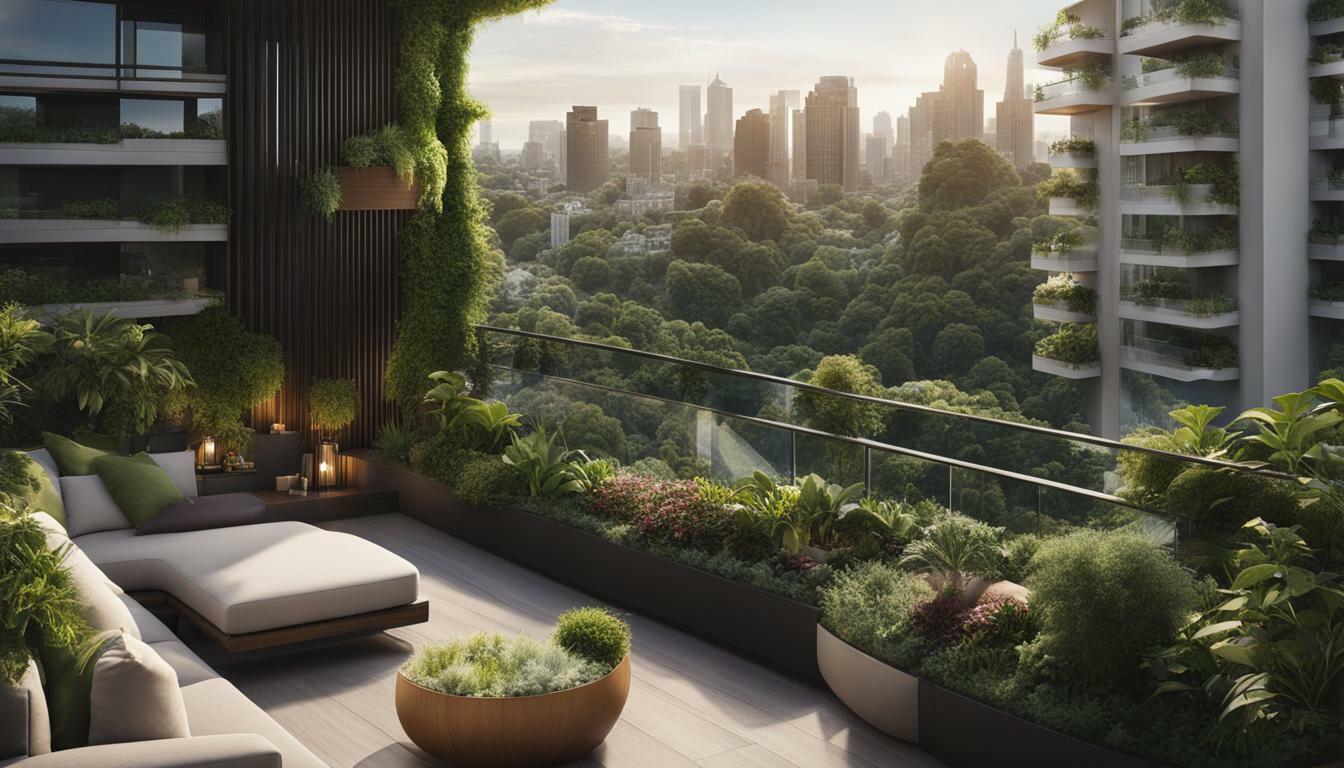Are you looking to transform your balcony into a lush, green haven? With this step-by-step guide, you can build your own vertical garden balcony and bring nature right to your doorstep. Vertical gardens are not only visually appealing but also a space-saving solution for urban environments. Whether you have a small balcony or limited space, you can create a beautiful and functional garden with vertical gardening techniques.
Key Takeaways:
- Create a vertical garden balcony to maximize limited space and bring nature to your doorstep.
- Choose the right location on your balcony that receives ample sunlight for optimal plant growth.
- Build a sturdy support system for your vertical garden using various materials and methods.
- Select the best plants suited for balcony gardens, such as annual vines, perennial vines, edible plants, and columnar plants.
- Maintain your vertical garden by following essential care tips, including proper watering, sunlight, and fertilization.
- Get inspired by design ideas to create a visually appealing vertical garden balcony using different types of planters and arrangements.
- Discover the benefits of vertical gardening in urban areas, including maximizing space, enhancing aesthetics, and providing a habitat for wildlife.
- Explore a real estate project that offers luxury flats with balconies ideal for vertical garden balconies.
- Learn about common challenges faced in vertical gardening and find practical solutions to overcome them.
- Summarize the key points discussed in the article and emphasize the importance of building a vertical garden balcony.
Choosing the Right Location for Your Vertical Garden Balcony
Before you start building your vertical garden balcony, it’s crucial to choose the right location that will provide optimal sunlight and space for your plants to thrive. Here are some important factors to consider when selecting the perfect spot for your vertical garden:1. Sunlight: Most plants require at least 6 hours of direct sunlight each day to grow well. Observe your balcony throughout the day to determine the areas that receive the most sunlight. Choose a location that gets ample sunlight, preferably in the morning or afternoon when the intensity is not too harsh. This will ensure that your plants receive the necessary light for photosynthesis and healthy growth.2. Wind Exposure: Consider the wind patterns on your balcony. Strong gusts of wind can damage delicate plants and cause them to dry out quickly. If your balcony is exposed to strong winds, create a windbreak by installing a trellis, windscreen, or other protective structure. This will help shield your plants from the wind and prevent them from getting damaged.3. Space Availability: Assess the available space on your balcony and determine how much space you can allocate for your vertical garden. Consider the size and number of planters or containers that you plan to use, as well as the support structure required. Make sure there is enough space for the plants to grow and spread their roots without overcrowding.4. Weight Capacity: Check the weight capacity of your balcony to ensure it can support the additional weight of your vertical garden. Some balconies may have weight restrictions, so it’s important to adhere to them to avoid any structural issues. Choose lightweight materials for your planters and consider using hanging systems or vertical supports that distribute the weight evenly.5. Drainage: Ensure that your chosen location has proper drainage to prevent excess water from accumulating and causing waterlogging. If your balcony doesn’t have natural drainage, you can use trays or saucers to collect excess water and prevent it from seeping into the floor or neighboring balconies.Remember, each balcony is unique, and the best location for your vertical garden will depend on the specific conditions of your balcony. Take the time to observe and analyze your balcony’s characteristics before finalizing the location for your vertical garden.Tables:
Please note that tables are not applicable to this section.Quote:“Before you start building your vertical garden balcony, it’s crucial to choose the right location that will provide optimal sunlight and space for your plants to thrive.”
- List:
| Factors | Considerations |
|---|---|
| Sunlight | 6 hours of direct sunlight per day |
| Wind Exposure | Protection from strong gusts of wind |
| Space Availability | Adequate room for planters and support structures |
| Weight Capacity | Balcony’s ability to support additional weight |
| Drainage | Prevention of waterlogging |
Image:
Building the Support System for Your Vertical Garden Balcony
The support system is the backbone of your vertical garden balcony, providing stability and structure for your plants to grow. Here’s how you can build a strong and reliable support system for your garden.
First, you need to choose the right materials for your support system. Options include metal grids, wooden frames, or PVC pipes. Consider the weight of your plants and the overall structure when selecting materials. It is also essential to ensure that the materials are weather-resistant and durable.
Once you have chosen the materials, it’s time to install the support system. Start by attaching the system to your balcony wall or railing. Make sure to secure it properly to prevent any accidents or damage. Use strong hooks, screws, or brackets to ensure stability.
Next, consider the spacing and arrangement of your planters. You can use vertical stacking techniques or staggered placement to maximize space. Ensure that each planter has enough room for plant growth and proper water drainage.
Finally, regularly inspect and maintain your support system. Check for any signs of wear or instability. Replace any damaged or weak components to ensure the safety and longevity of your vertical garden balcony.
Table 1: Materials for Building a Support System
| Material | Description |
|---|---|
| Metal Grids | Durable and sturdy option, suitable for heavy plants |
| Wooden Frames | Natural and visually appealing, requires regular maintenance |
| PVC Pipes | Lightweight and easy to work with, ideal for small plants |
By following these steps and using the right materials, you can build a strong and reliable support system for your vertical garden balcony. This will ensure that your plants thrive and create a beautiful green space in your small balcony.
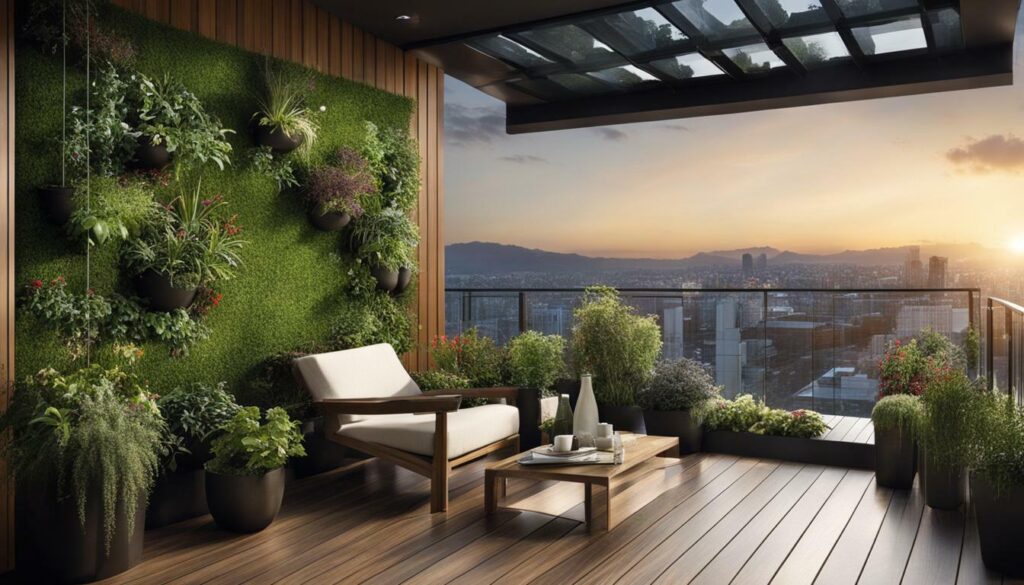
“The support system is the backbone of your vertical garden balcony, providing stability and structure for your plants to grow.”
Selecting the Best Plants for Your Balcony Garden
Choosing the right plants is crucial for a successful vertical garden balcony. Here are some recommendations for the best plants that will thrive in the limited space of your balcony.
1. Herbs: Herbs are perfect for balcony gardens as they are compact and can be grown in small pots. Some popular choices include basil, rosemary, mint, and thyme. These herbs not only add flavor to your meals but also give off a pleasant fragrance.
2. Succulents: Succulents are low-maintenance plants that can withstand dry conditions. They come in various shapes and colors, adding a touch of beauty to your balcony. Jade plants, aloe vera, and echeveria are some great options for succulent lovers.
3. Flowering Plants: Brighten up your balcony with colorful flowers. Marigolds, petunias, and geraniums are easy to grow and will provide a burst of vibrant colors. Hanging baskets or vertical planters can be used to showcase these beautiful blooms.
4. Vegetables: Grow your own vegetables on your balcony! Cherry tomatoes, lettuce, peppers, and herbs like cilantro and parsley can be successfully grown in containers. Just make sure they receive enough sunlight and regular watering.
5. Compact Fruits: If you have a larger balcony, consider growing compact fruit trees such as dwarf citrus trees. They can add a touch of freshness and provide you with homegrown fruits like lemons or oranges.
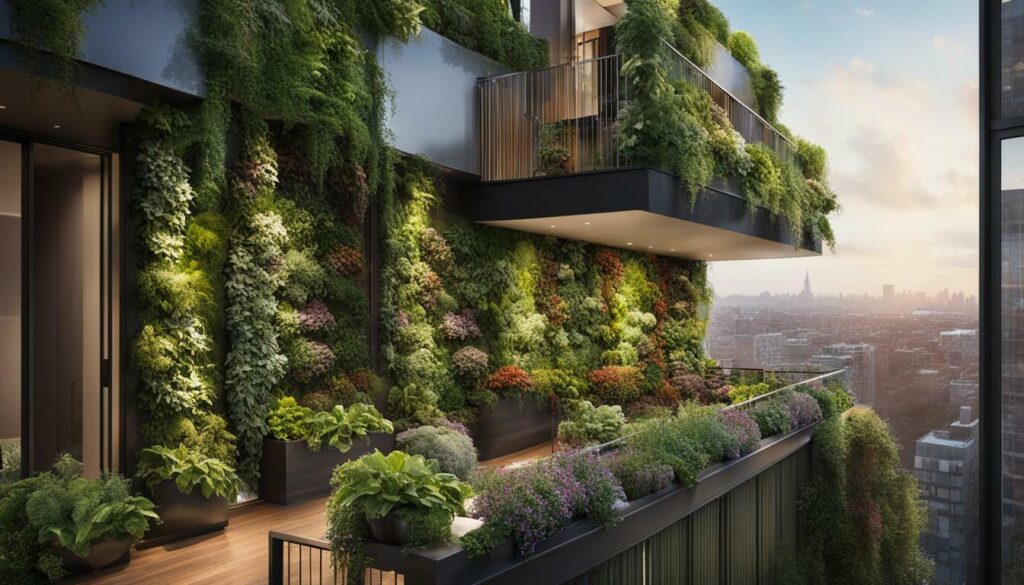
“Vertical gardens bring a touch of greenery to small spaces.”
Quick Tips:
- Choose plants that are suitable for your climate and balcony conditions.
- Consider the amount of sunlight and shade your balcony receives throughout the day.
- Ensure proper drainage for your plants to avoid waterlogging.
- Use high-quality potting soil and fertilizers for optimal plant growth.
- Regularly inspect your plants for pests or diseases and take necessary measures to prevent or treat them.
Table: Best Plants for Balcony Gardens
| Plant Type | Recommended Plants |
|---|---|
| Herbs | Basil, Rosemary, Mint, Thyme |
| Succulents | Jade Plant, Aloe Vera, Echeveria |
| Flowering Plants | Marigolds, Petunias, Geraniums |
| Vegetables | Cherry Tomatoes, Lettuce, Peppers, Cilantro, Parsley |
| Compact Fruits | Dwarf Citrus Trees |
Incorporating these plants into your balcony garden will not only add beauty and freshness but also provide you with the joy of growing your own plants and produce. Experiment with different combinations and arrangements to create a stunning vertical garden that suits your taste and style.
Vertical gardens bring a touch of greenery to small spaces, creating a refreshing and inviting ambiance.
Caring for Your Vertical Garden Balcony
Once your vertical garden balcony is set up, it’s important to provide proper care and maintenance to ensure the health and vitality of your plants. Here are some essential tips for caring for your vertical garden balcony:
- Watering: Keep a close eye on the water requirements of your plants. Excess water should be collected in a tray at the base, which can be reused or drained off. Be sure to water your plants regularly, taking into consideration the specific needs of each plant.
- Sunlight: Adequate sunlight is crucial for the growth and development of your plants. However, it’s important to note that different plants have varying sunlight requirements. Some may thrive in direct sunlight, while others may require shade at the roots. Adjust the placement of your plants accordingly to ensure they receive the appropriate amount of sunlight.
- Soil and Fertilization: Use quality topsoil or potting mix for your vertical garden balcony. This will provide essential nutrients and support healthy plant growth. Additionally, consider using slow-releasing fertilizers to nourish your plants over time.
- Pruning and Maintenance: Regularly prune your plants to promote healthy growth and prevent overcrowding. Remove any dead or diseased leaves, as well as any weeds or unwanted plants that may compete for resources. Ensure that the support system for your vertical garden balcony remains sturdy and secure.
- Pest Control: Monitor your plants for any signs of pests or diseases. Take appropriate measures to control and prevent infestations, such as using organic pest control methods or introducing beneficial insects to your garden.
Expert Tip:
“When caring for your vertical garden balcony, remember to pay attention to the specific needs of each plant. Some plants may require more water, while others may thrive in less sunlight. Regularly assess the condition of your plants and make adjustments as needed to ensure their overall health and well-being.”
By following these care tips, you can maintain a vibrant and thriving vertical garden balcony that will bring beauty and greenery to your urban space.
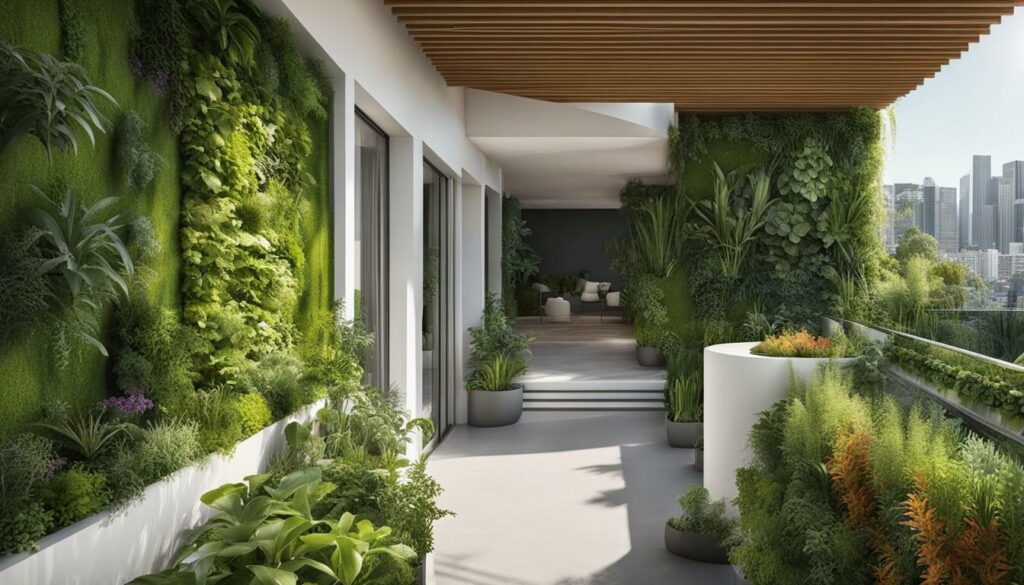
| Watering | Sunlight | Soil and Fertilization | Pruning and Maintenance | Pest Control |
|---|---|---|---|---|
| Monitor water requirements | Provide adequate sunlight | Use quality topsoil or potting mix | Regularly prune and maintain plants | Control and prevent pests |
Remember, caring for your vertical garden balcony is an ongoing process. Stay vigilant and attentive to the needs of your plants, and you will be rewarded with a flourishing and beautiful balcony garden.
Design Ideas for Your Vertical Garden Balcony
Designing your vertical garden balcony is an opportunity to unleash your creativity and create a stunning visual display. Here are some design ideas to help you get started:
- Colorful Planters: Use a variety of colorful planters to add bursts of vibrant hues to your vertical garden balcony. Opt for planters in different shapes, sizes, and materials to create an eye-catching arrangement.
- Vertical Herb Garden: Create a vertical herb garden by planting different herbs in small pots or hanging baskets. Arrange them in a way that is both functional and visually appealing, so you have easy access to fresh herbs while adding greenery to your space.
- Living Wall: Transform a section of your balcony into a living wall by covering it with trailing plants. Choose plants with cascading foliage, such as English ivy or creeping jenny, to create a lush, green backdrop.
- Hanging Baskets: Hang baskets filled with colorful flowers or trailing vines from the ceiling or railing of your balcony. This will add depth and visual interest to your vertical garden.
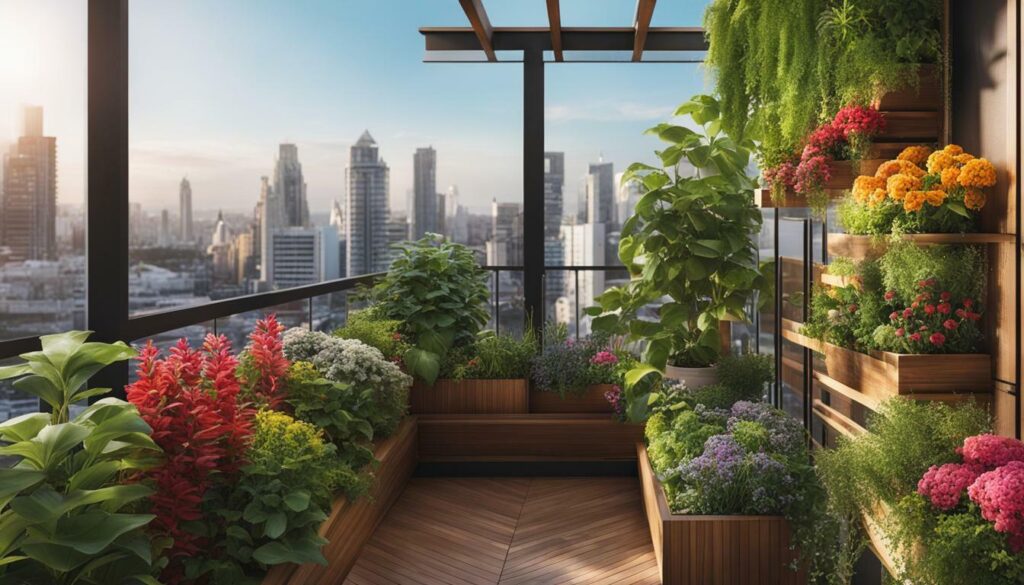
Remember to consider the specific needs of your plants, such as sunlight and watering requirements, when arranging them in your vertical garden balcony. Experiment with different combinations and arrangements to create a unique and personalized space that reflects your style and taste.
Benefits of Vertical Gardening in Urban Areas
Vertical gardening is a game-changer for urban dwellers, allowing them to grow their own plants and create green spaces in limited areas. Here are some key benefits of vertical gardening in urban areas:
- Maximizes limited space: Urban areas often lack the space for traditional gardening, but with vertical gardening, even a small balcony or wall can be transformed into a thriving garden. By utilizing vertical space, urban gardeners can grow a variety of plants without needing a large plot of land.
- Enhances the aesthetic value: Vertical gardens add greenery and beauty to urban spaces, turning concrete jungles into lush oases. The vertical arrangement of plants creates a visually appealing display that can improve the overall aesthetic of any urban area.
- Provides a habitat for wildlife: Vertical gardens attract various forms of wildlife, such as birds, bees, butterflies, and insects. These gardens provide a much-needed habitat for these creatures in urban environments, contributing to biodiversity and ecosystem health.
Moreover, vertical gardening has additional advantages such as reducing urban heat island effect, improving air quality, and providing insulation to buildings. This sustainable gardening method allows individuals in urban areas to reconnect with nature while enjoying the numerous benefits it offers.
Real Estate Project Spotlight: Urban Skyline Phase 2
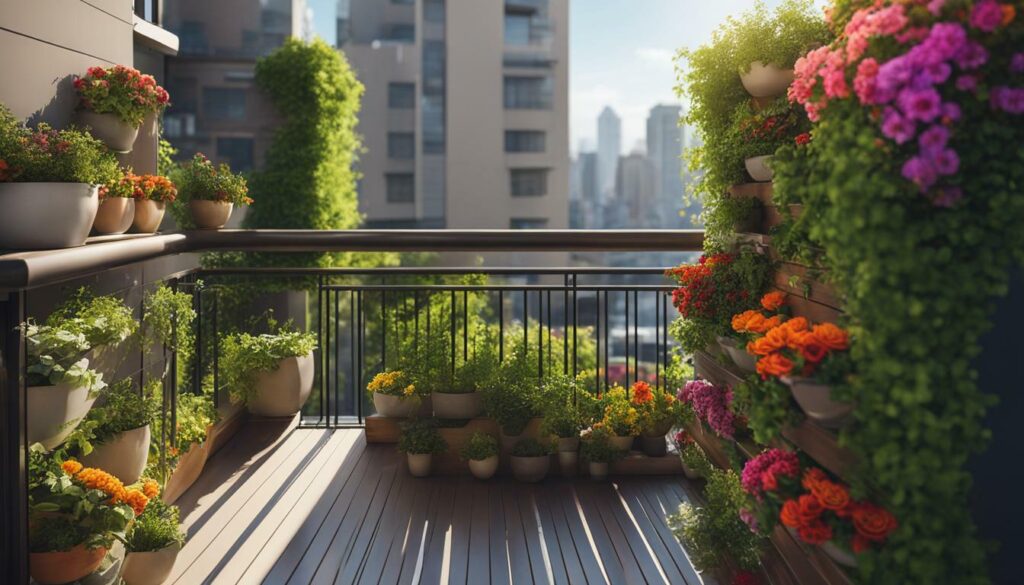
If you’re looking for a luxury residential project that promotes eco-friendly living and offers balconies ideal for vertical gardens, consider Urban Skyline Phase 2. Located in Ravet and near the Mumbai-Pune expressway, this project by Urban Space Creators provides spacious rooms and balconies, allowing residents to create their own vertical garden oasis. With thoughtful amenities and a focus on sustainability, Urban Skyline Phase 2 offers the perfect combination of luxury living and urban gardening.
In conclusion, vertical gardening in urban areas is a practical and visually appealing way to create green spaces and grow plants in limited areas. It maximizes space, enhances the aesthetic value, and provides a habitat for wildlife. Whether you have a small balcony or a large wall, vertical gardening allows urban dwellers to enjoy the benefits of gardening while embracing sustainable living.
| Benefits of Vertical Gardening in Urban Areas |
|---|
| Maximizes limited space |
| Enhances the aesthetic value |
| Provides a habitat for wildlife |
Real Estate Project Spotlight: Urban Skyline Phase 2
Looking for a luxury apartment with the perfect space for your vertical garden balcony? Explore Urban Skyline Phase 2, a premium residential project that combines elegant living spaces with eco-friendly features. This project, located in Ravet near the Mumbai-Pune expressway, is designed to promote eco-friendly living and offers luxury flats that are ideal for creating your own vertical garden oasis.
Urban Skyline Phase 2 provides the perfect setting for your balcony garden with its spacious balconies and abundant sunlight. The apartments are designed to maximize space and offer ample room for your vertical garden setup. Whether you prefer hanging wall planters, vertical picture frame planters, or even a bamboo trellis, the balconies in Urban Skyline Phase 2 provide the ideal backdrop for your creative gardening ideas.
The amenities in Urban Skyline Phase 2 are thoughtfully designed to enhance your living experience. From well-maintained gardens and landscaped areas to a dedicated area for composting and recycling, this project encourages sustainable living. The lush green spaces and vertical gardens not only add beauty to the surroundings but also help to cool the air and provide a habitat for birds, bees, and other wildlife.
| Amenities | Location | Price Range |
|---|---|---|
| Well-maintained gardens | Ravet, near Mumbai-Pune expressway | $500,000 – $1,000,000 |
| Landscaped areas | ||
| Composting and recycling facilities |
If you’re interested in luxury flats for sale in Ravet, Urban Skyline Phase 2 offers the perfect blend of luxury, sustainability, and a vibrant living environment. With its vertical garden-friendly balconies and eco-friendly amenities, this project is a testament to the growing popularity of vertical gardening in urban areas.
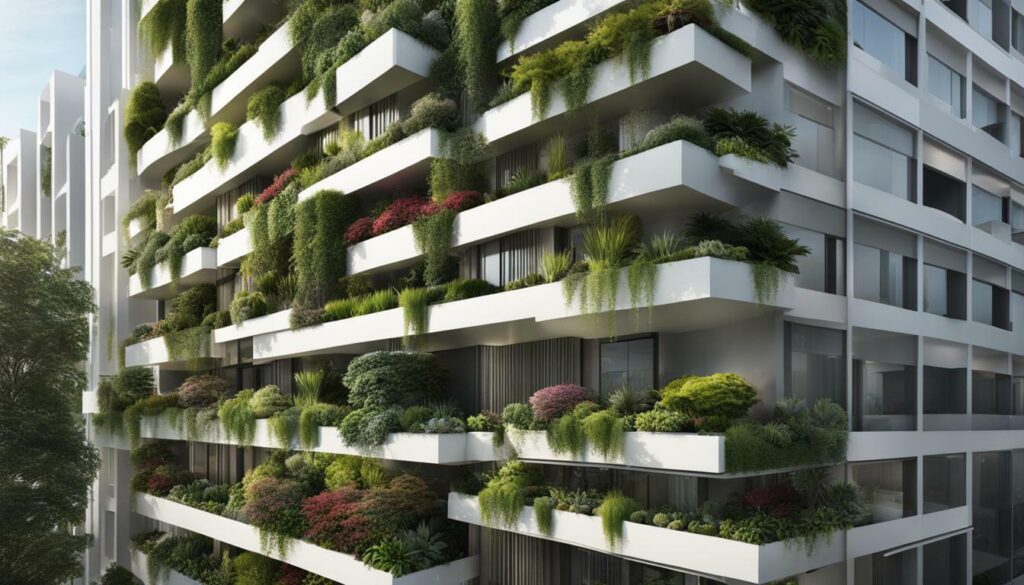
Customer Testimonial: Creating a Vertical Garden Haven
“I’ve always loved gardening, but living in a small apartment limited my options. When I discovered Urban Skyline Phase 2, I knew it was the perfect place for me. The spacious balconies and abundant sunlight provided the ideal space for my vertical garden. Now, I can enjoy fresh herbs and vegetables right outside my door, and the lush greenery adds so much beauty to my living space. I’m grateful for this eco-friendly project and the opportunity to create my own garden haven.”
– Maria Anderson, Resident of Urban Skyline Phase 2
Common Challenges and Solutions for Vertical Garden Balconies
While vertical garden balconies offer many benefits, they can also come with their own set of challenges. Here are some common issues and solutions to help you navigate the potential obstacles.
Challenge: Limited Space
One of the main challenges of vertical garden balconies is the limited space available. Balconies are usually small, and finding enough room to accommodate your plants can be a struggle. However, there are solutions to make the most of the space you have:
- Opt for compact plants that don’t require much horizontal space but can grow vertically, such as herbs, lettuce, and strawberries.
- Utilize wall-mounted planters, hanging baskets, and trellises to maximize vertical space.
- Consider using a tiered shelving system or vertical plant stand to create multiple levels for your plants.
Challenge: Sunlight Limitations
Another challenge for vertical garden balconies is the limited amount of sunlight that reaches them. Depending on the orientation of your balcony, you may have to deal with shade from nearby buildings or limited direct sunlight. Here are some solutions to overcome this challenge:
- Choose plants that are suitable for partial shade or shade conditions, such as ferns, begonias, and impatiens.
- Position your plants strategically to take advantage of the available sunlight. Observe the sun patterns on your balcony and adjust the placement of your planters accordingly.
- Consider using reflective surfaces, such as mirrors or light-colored walls, to bounce sunlight onto your plants and maximize their exposure.
Challenge: Watering and Drainage
Proper watering and drainage are crucial for the health of your vertical garden balcony. Over-watering or poor drainage can lead to root rot and other plant diseases. Here are some solutions to ensure adequate watering and drainage:
- Choose planters with drainage holes to allow excess water to escape. Alternatively, you can create your own drainage system by adding a layer of gravel or small rocks at the bottom of your planters.
- Water your plants regularly, but make sure not to overwater. Check the moisture levels in the soil before watering to prevent waterlogged roots.
- Consider using self-watering systems or irrigation systems with timers to automate the watering process and ensure your plants receive the right amount of water.
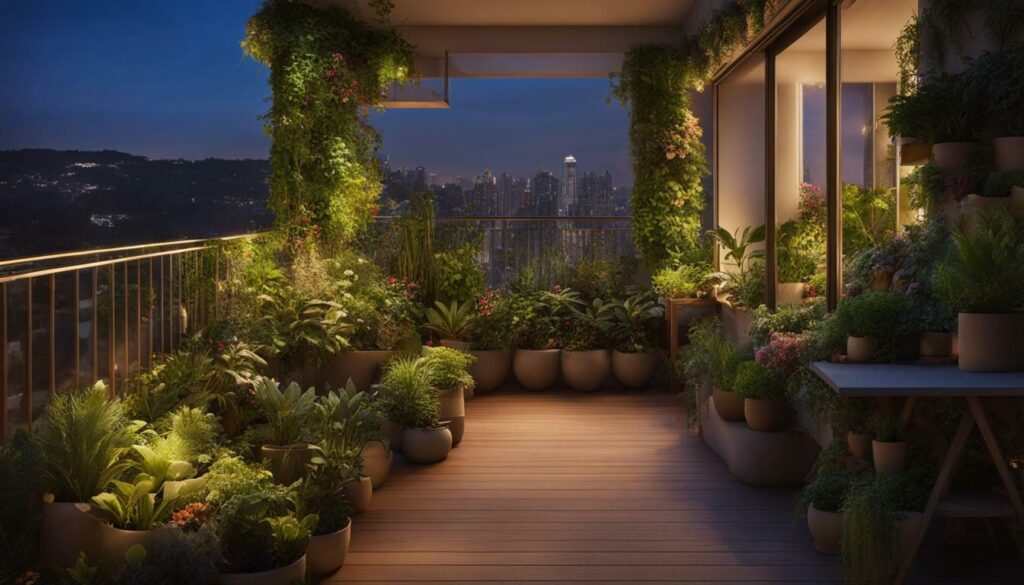
Challenge: Maintenance and Pest Control
Maintaining a vertical garden balcony requires regular care and attention. Additionally, pests can be a common problem for balcony gardens. Here are some solutions to keep your vertical garden healthy and pest-free:
- Regularly prune and trim your plants to promote healthy growth and prevent overcrowding.
- Monitor your plants for signs of pests, such as aphids or spider mites. Use organic pest control methods, such as neem oil or insecticidal soap, to keep them at bay.
- Keep your balcony clean and free from debris to prevent the build-up of pests and diseases.
- Provide proper nutrition to your plants by using organic fertilizers and compost.
In conclusion, while vertical garden balconies may present some challenges, with careful planning and the right strategies, you can create a beautiful and thriving garden in your limited space. By maximizing vertical space, selecting suitable plants, ensuring proper watering and drainage, and staying on top of maintenance and pest control, you can enjoy the benefits of a lush and vibrant balcony garden.
Conclusion
Building your own vertical garden balcony is a rewarding and sustainable way to bring nature into your small urban space. With careful planning and the right techniques, you can create a green haven that will not only beautify your balcony but also improve your overall well-being.
By choosing the right location for your vertical garden balcony, considering factors such as sunlight and wind conditions, you can ensure the optimal growth of your plants. Building a sturdy support system is crucial to ensure the stability and longevity of your vertical garden. There are various methods and materials available to create a strong and durable framework.
When selecting plants for your balcony garden, consider factors such as their suitability for small spaces and their ability to thrive in vertical environments. Annual vines, perennial vines, edible plants, and columnar plants are great choices for vertical gardens. Take into account the sunlight requirements and water availability for each plant and create a balanced mix of greenery and aesthetics in your balcony garden design.
Caring for your vertical garden balcony involves regular watering, providing adequate sunlight, and using high-quality topsoil and slow-releasing fertilizers. It’s important to monitor the water requirements of your plants and ensure proper drainage to avoid waterlogging. Different plants have varying sunlight needs, so be mindful of their specific requirements. Using quality soil and fertilizers will provide the necessary nutrients for healthy plant growth.
Design ideas for your vertical garden balcony are plentiful and varied. From pallet vertical gardens to planter pots, there are endless possibilities to create a visually appealing and functional balcony garden. Experiment with different arrangements and planters to achieve a unique and attractive design.
Vertical gardening offers numerous benefits in urban areas. It maximizes limited space, enhances the aesthetic value of your balcony, and provides a habitat for wildlife. By creating green spaces in urban environments, we can contribute to a healthier and more sustainable future.
Considerations for building and maintaining a vertical garden balcony include common challenges such as weight restrictions, sunlight limitations, and proper plant care. By addressing these challenges with practical solutions and tips, you can overcome obstacles and create a thriving vertical garden.
In conclusion, building your own vertical garden balcony is a creative and fulfilling endeavor that allows you to bring nature into your urban space. With the right approach and a little creativity, you can transform your balcony into a beautiful oasis filled with greenery and life.
Can I Use the Ideas for Vertical Gardens on My Balcony to Build My Own?
Yes, you can use the top balcony vertical garden ideas to create your own green oasis. With clever use of space-saving containers, hanging planters, and vertical trellises, you can maximize your balcony space and enjoy a lush and thriving garden right outside your door.
FAQ
Q: What is a vertical garden balcony?
A: A vertical garden balcony is a garden that is grown vertically, often on a wall or other surface, to maximize limited space in small balcony areas. It is a space-saving and visually appealing way to grow plants in urban environments.
Q: How do I choose the right location for my vertical garden balcony?
A: When choosing the location for your vertical garden balcony, consider the amount of sunlight the area receives, the strength of the support wall, and the ability of the location to withstand moisture. Choose a sunny wall with direct sunlight access and ensure the support system is strong enough to carry the weight of the overall setup.
Q: What types of plants are best for a balcony garden?
A: There are several types of plants that are well-suited for balcony gardens. Annual vines, such as cardinal climber and moonflower, are climbers that grow best in ample sunlight. Perennial vines like clematis hybrids and ivy can be grown quickly under ample sunlight. Edible plants like kiwi, peas, and tomatoes, as well as columnar plants like apple trees and junipers, are also great options for a balcony garden.
Q: How do I take care of a vertical garden balcony?
A: To take care of a vertical garden balcony, it is important to keep a tab on the water requirements of the plants and collect excess water in a tray at the base. Adequate sunlight should be provided, but the requirement for sunlight varies from plant to plant. Quality topsoil should be used, and slow-releasing fertilizers can be used for the top layer.
Q: What are some design ideas for a vertical garden balcony?
A: There are several design ideas for a vertical garden balcony, including using pallets as vertical gardens, using planter pots, and arranging shelves to keep pots. These design ideas can help make your vertical garden balcony look stunning and maximize the use of limited space.
Q: What are the benefits of vertical gardening in urban areas?
A: Vertical gardening in urban areas helps to maximize limited space, enhance the aesthetic value, and provide a habitat for various birds, bees, butterflies, and other wildlife. It also helps to cool the surrounding air and promotes eco-friendly living in urban environments.
Q: What are some common challenges and solutions for vertical garden balconies?
A: Some common challenges of vertical garden balconies include choosing the right plants for the space, ensuring proper support and stability, and managing water requirements. Solutions include researching the best plants for your balcony, building a sturdy support system, and monitoring the water needs of your plants.
Q: What is the Urban Skyline Phase 2 real estate project?
A: Urban Skyline Phase 2 is a premium residential project in Ravet that promotes eco-friendly living and offers luxury homes with balconies ideal for vertical garden balconies. It is located near the Mumbai-Pune expressway and offers spacious rooms and thoughtful amenities for residents.
Q: What are the benefits of building a vertical garden balcony?
A: Building a vertical garden balcony allows you to maximize limited space, add greenery to your living space, enhance the aesthetic value, and contribute to a more eco-friendly and sustainable lifestyle. It also provides a peaceful and refreshing outdoor space right outside your sliding doors.
Q: How can I overcome common challenges faced when building and maintaining a vertical garden balcony?
A: To overcome common challenges, research the best plants for your specific balcony conditions, ensure a sturdy support system is in place, monitor the water needs of your plants, and be proactive in addressing any issues that arise. Regular care and maintenance, along with proper planning and organization, can help overcome challenges and ensure the success of your vertical garden balcony.
Q: What are the key points to remember when building a vertical garden balcony?
A: When building a vertical garden balcony, remember to choose the right location with adequate sunlight, build a strong support system, select the best plants for your balcony, provide proper care and maintenance, and explore different design ideas to make your balcony garden visually appealing and functional.

